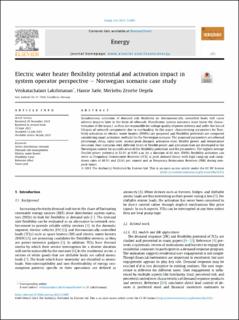| dc.contributor.author | Lakshmanan, Venkatachalam | |
| dc.contributor.author | Sæle, Hanne | |
| dc.contributor.author | Degefa, Merkebu Zenebe | |
| dc.date.accessioned | 2022-02-28T12:04:19Z | |
| dc.date.available | 2022-02-28T12:04:19Z | |
| dc.date.created | 2021-07-16T13:17:01Z | |
| dc.date.issued | 2021 | |
| dc.identifier.issn | 0360-5442 | |
| dc.identifier.uri | https://hdl.handle.net/11250/2981687 | |
| dc.description.abstract | Simultaneous activation of demand side flexibility on thermostatically controlled loads will cause adverse impacts later in the form of rebounds. Distribution system operators must know the characterisation of the impact, as they are responsible for voltage quality of power delivery and suffer the loss of lifespan of network components due to overloading. In this paper, characterising parameters for flexibility activation on electric water heaters (EWHs) are proposed and flexibility potentials are computed considering smart activation methods for the Norwegian scenario. The proposed parameters are rebound percentage, delay, ramp rates, second peak distance, activation error, flexible power, and temperature deviation. Four scenarios with different levels of flexible power and activation time are developed in the Norwegian context for quantification of the flexibility potentials and the parameters. The highest average flexible power potential is 53.9 % at 8:00 AM for a duration of 61 minutes. EWHs flexibility activation can serve as Frequency Containment Reserves (FCR) at peak demand hours with high ramp-up and ramp-down rates of 48.5 % and 23.8 % per minute and as Frequency Restoration Reserves (FRR) during non-peak hours. Keywords Active distribution networkDemand side managementElectric water heaterFlexibility valueRebound effectSmart grid | en_US |
| dc.language.iso | eng | en_US |
| dc.publisher | Elsevier | en_US |
| dc.rights | Navngivelse 4.0 Internasjonal | * |
| dc.rights.uri | http://creativecommons.org/licenses/by/4.0/deed.no | * |
| dc.title | Electric water heater flexibility potential and activation impact in system operator perspective – Norwegian scenario case study | en_US |
| dc.type | Peer reviewed | en_US |
| dc.type | Journal article | en_US |
| dc.description.version | publishedVersion | en_US |
| dc.rights.holder | The Authors | en_US |
| dc.source.volume | 236 | en_US |
| dc.source.journal | Energy | en_US |
| dc.identifier.doi | 10.1016/j.energy.2021.121490 | |
| dc.identifier.cristin | 1921944 | |
| dc.relation.project | Norges forskningsråd: 255209 | en_US |
| dc.relation.project | Norges forskningsråd: 257626 | en_US |
| dc.source.articlenumber | 121490 | en_US |
| cristin.ispublished | true | |
| cristin.fulltext | original | |
| cristin.qualitycode | 2 | |

